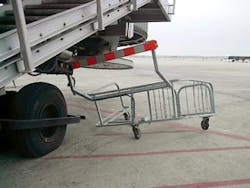By Enrique Feduchy, managing director, airports division, TEAM
Ten years ago, when I joined a leading GSE company, I was involved in the first projects that had taken place in Spain to equip all passenger boarding bridges with preconditioned air (PCA) units, ground power converters (400Hz) and auxiliary equipment.
These were exciting times as the trend of the ’90s to “go green” and other operational improvements around the ramp and parking platform was in full swing; and, as a matter of fact, they still are today.
But at the time, the main objective for airport authorities and airliners was only to stop using the aircraft’s auxiliary power units (APU) and provide the airport terminal with auxiliary fixed equipment to supply preconditioned air and ground power to stationed aircrafts.
Lots of different designs and technologies where adopted to fulfill customers’ needs, but once the APU problem was solved, a new issue arose regarding these new auxiliary systems and their interaction with ground staff.
Applying innovation to ground support
As customers were getting used to these new auxiliary GSE systems, they also started to discover a lack of ingenuity applied to some of these systems. What apparently seemed like a simple process of deploying and storing PCA hoses or ground power cables actually caused huge problems in regard to efforts to reach the desired turnaround time.
So, what then was wrong? Well, first of all, the hoses used to provide preconditioned air to the aircraft had 14 inches of outside diameter with a length of 20 feet per section. The hoses zipped together to reach the most common aircraft were usually divided into three to four sections, which meant that ground staff at the parking area had to deal with on average no less than 80 feet of heavy hoses every single time an aircraft demanded the PCA service.
Secondly, after all these years of inventions, the most common known solution to store these hoses was via a simple nonhi-tech basket, attached to a wheel bogie under the passenger boarding bridge. This solution led to a constant conflict with the rest of the GSE working on the maneuvering area, and a significant number of accidents.
To solve these problems and contribute to an improved turnaround time, TEAM designed and developed a complete set of auxiliary equipment solutions.
How did we improve turnaround time?
The Telescopic Automatic Hose Retriever is one of the most innovative and revolutionary solutions available on the market today. This device has recently been launched exclusively by our company and has been designed to deploy and retrieve PCA hoses in a very clean and fast way. It is capable of storing all of the hose inside the telescopic duct, protecting it from a premature wear-out through direct exposure to the environment, thus offering a very significant reduction in maintenance costs. In addition, the system provides an excellent driveability of the ducts and consequently an increase in the safety, security and reliability of ground operations.
All these features are already impressive and demonstrate a great improvement compared to what had been achieved up until today. However, the most remarkable advantage that this new system provides is its unique capacity to automatically extend the exact length of hose needed for each operation, using the least amount of tarmac space possible. And, finally, the fact that this retriever makes a storage hose basket under the passenger boarding bridge redundant, makes this auxiliary GSE a great state-of-the-art improvement.
All of this inevitably leads to quicker servicing, more efficient operations and a significant improvement in turnaround, which demonstrated that applying innovations at ground level delivers important benefits to airlines and their passengers in terms of speed, security and safety.
Now the question is: can every single airport around the world benefit from these new features and innovative inventions? The answer is yes. TEAM, as a former aircraft passenger boarding bridges manufacturer, has designed these new Automatic Hose Retrievers to adapt them to every single PCA application. Whether there is a PCA unit hanging from the bridge or stand mounted under the rear rotunda, the Automatic Hose Retriever will fit into the application.
This is just an example of how we can contribute through innovation and ingenuity to help improve the operations around the aircraft parking area. More changes are still needed; there are lots of things that can be easily modified to obtain better performance. We should stop for a while and look around, and make sure we don’t miss any other opportunities to achieve excellence in ground support: the knock-on effect to keep up with busy schedules at the world’s airports are too good to miss.





